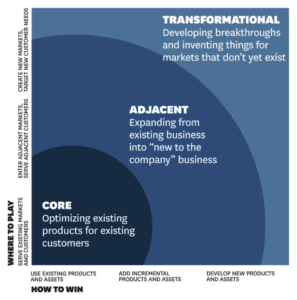In David Yoffie’s new Strategy Rules: Five Timeless Lessons from Bill Gates, Andy Grove, and Steve Jobs he and co-author, Michael Cusumano have reviewed Bill Gates, Andy Grove, and Steve Jobs, strategy and leadership decisions and have identified five key lessons to strategy success:
- Start with a vision of where you want to go and this should be defined in great detail
- Think big. Make bold bets that can change the game and do this without betting the company
- Build platforms and ecosystems and not just products
- The fourth and fifth are more around the execution: Tactics and
- How you execute.
Yoffie defines the vision of the company to be the most important and starting point for great strategy as it defines, where the company is heading and how it will get there and as I have mentioned before, allows you to fully engage your team. With the relatively short reporting and budgeting cycles spending time on the vision is often overlooked. He defines the vision as the ability to look forward and reasons back to today. In essence you need to be able to think several steps ahead into the future and then think about what you have to do today in order to reach that position.
One tool that has been around for a while that can help frame this vision is the McKinsey three horizon model. This model was developed from McKinsey & Co.’s discoveries of the common factors amongst companies that experience significant and consistent growth.
Horizon 1: Extend and defend core businesses/enterprises
The ‘extend and defend’ stage is all about protecting existing revenue sources, which usually consist of a business’s main products and services. McKinsey identified that by year 4 or 5, a significant potion of revenue comes from products or services that are new to the company.
Horizon 2: Identify future options and build platform for emerging businesses
This is what we know today and entering new markets with new products. As this horizon is still ‘close’ one of the benefits is you will see who your competitors are. Your Horizon 1 may be another company’s Horizon 2, and this can be seen where industries begin to collide into each other. An example of this is visibly playing out at the moment with the blurring of the lines between media companies and telco’s. Spark with Lightbox, BskyB (UK) owns a broadband company, Cable Companies delivering internet etc.
This horizon can be a challenge for operational managers as developing products and services within this horizon typically has high costs to the business and little or no return in the short term.
Horizon 3: Create and implement viable options
Three Horizon framework is about having strategic conversations about the future and feeds the conversation about your innovation direction and longer-term portfolio and capability requirements of the business. This will be the most ‘uncomfortable’ area for operational managers as it has the most uncertainty however this is the area where disruption and innovation really comes from.
While always much easier in hindsight, here is how the three horizon model may have looked for the home video rental market for Video / DVD stores 5-10 years ago.
Horizon 1 – Begin to migrate stock from Video to DVD as DVD perpetration increases. Adjust pricing and offer bundles such as ‘One weekly DVD with ever new release, weekly pricing, change the format of stores.
Horizon 2 – DVD mail order subscription models such as Netflix and Fatso, DVD kiosks at high traffic areas
Horizon 3 – Video on Demand such as Netflix, Lightbox and Neon.
Finally while not defining the process as the three horizon process, Google uses a similar model where they allocate time based on 70/20/10 whereby 70% is on the core, 20% on new (Horizon 2) and 10% on the radical (Horizon 3).
Key Takeaways:
- Being able to predict the future and identifying where you play and how you can win is one of the key, if not the key part of strategy and leadership. It is important that the leadership team puts regular time aside to review, discuss and align on where they are heading.
- Tools like the three horizon model can aid the discussion and it is tempting to start with Horizon 1 then work to Horizon 2 and then 3, however you will get much more powerful results if you focus on reversing the order, Horizon 3 is the future you need to work out how to get there.
KS.






